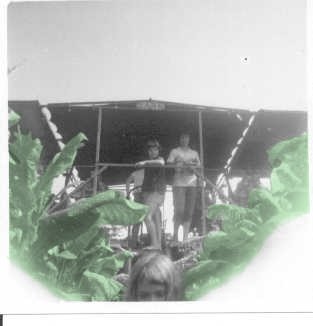Tobacco Farming before Automation

My mother and a cousin on the harvester
Tobacco (Nicotiana tabacum) is a plant that is consumed in virtually every country on Earth. It is thought to have been cultivated some 6,000 years ago in the Americas. Many native tribes attributed spiritual significance to the plant.
Farmers in the deep south grew tobacco when I was a child. Besides peanuts, tobacco was one of the main cash crops.
Tobacco season is south Georgia starts in late February or early March with preparation of seed beds. These beds are maybe 6 feet wide and several feet long depending on how many plants you needed to start. Wooden boards typically 2x12s were placed around the already tilled beds and staked down. Tobacco seeds are then broadcast into the beds. Tobacco seeds are incredibly tiny. It would take several hundred to fill a thimble. The bed is lightly watered and clear plastic is put over it to create a small greenhouse.
Around the end of March or the first of April these plants are pulled, boxed and taken to the fields where they are going to be transplanted.
The transplanter was pulled behind a tractor across the field. It had a chain-driven mechanism that was engaged by lowering the working parts to ground level.
A small subsoiler would open the ground about two inches wide and deep and inject a small bit of water. A clasper on a chain would drop a plant into the hole and as the machine moved a pair of plows would cover the back up. There were several claspers on the chain. A person sits on a seat and as the clasper comes over the top of the chain it opens up and a plant is put in it. As the chain moves down, the clasper closes taking the plant down to be planted. The mechanism was timed so that plants were 18 inches apart in the row. The rows were 36 inches apart.
There would be at least 1 kid walking behind the transplanter with a handful of plants and a stick to fill any gaps that had been left by the implement.
The tobacco would then be plowed and fertilized a couple of weeks later having given the roots time to grow and establish.
The end of school in our community was always the first Friday in June. I would recruit some of my friends to come and work with me during the summer. We were usually in the field by 6AM and worked until the days work was done.
The first job in the field was to hoe and pull weeds. The plows could only remove the vegetation growing in the row middles. We had to get rid of the cockleburrs, lamb's quarters, pig weed, and various grasses like Texas millet. These all have large root systems and if they got much over waist high were difficult to pull. One type of pig weed has the additional nuisance of having thorns.
The next job was to top and sucker the tobacco. Suckers are new growth limbs that emerge between the leaves and the main stalk. The tops are where the flowers are. They both take resources away from the existing leaves which causes them not to grow as large or as quickly as needed. Topping the plants also stops their vertical growth and they are forced to put their energy into their leaves.
Harvesting the tobacco started shortly after that. In the picture above, a high-boy self-propelled harvester is moving down a row. There are four people sitting in suspended seats just above the ground. They break off three or four of the bottom leaves and put them between two closely spaced parallel belts. These belts carry the tobacco to the top of the platform and dropped in a tray where workers would either tie them to a 3/4" x 3/4" x 3' stick or put them in a metal rack depending on what kind of barn was being used. The tobacco would then be placed in the barns to cure for a week. Slow baking speeds up the process. The tobacco is then taken out of the barn, placed on large burlap sheets and taken to market to be sold.
We would crop a field three or four times until all the tobacco was gone.
This was all incredibly hot, dirty work. Tobacco has a sticky resin that attracts dust and dirt. The afternoon temperatures are in the upper 90s or low 100s and the humidy is usually very high. The tobacco is tall enough that it blocks whatever breeze there may be and there is no shade when you're doing leg work.
I don't live in the area any more so I don't know how things are done these days. I'm pretty sure, though, that finding people willing to do this work would be difficult.
Times have changed.
Congratulations, your post has been selected to be included in my weekly Sustainability Curation Digest for the Minnow Support Project.
Thank you!
Congratulations @uthus2k! You have completed the following achievement on the Steem blockchain and have been rewarded with new badge(s) :
You can view your badges on your Steem Board and compare to others on the Steem Ranking
If you no longer want to receive notifications, reply to this comment with the word
STOPTo support your work, I also upvoted your post!